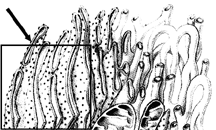Genes influence all aspects of life because they
A) are structural elements of the cell.
B) regulate movement of proteins.
C) produce RNA and protein needed for different processes.
D) localize to the nucleus.
E) are needed for DNA synthesis.
C
You might also like to view...
What is the sequence of events involved in the production of proteins that is secreted?
A) A hormone signals the gene that encodes the protein to be transcribed into mRNA in the nucleus. The mRNA is translated into protein on the ER, then processed and folded in the Golgi apparatus, and then sent out of the cell in a vesicle. B) A hormone signals a protein-filled vesicle to move from the plasma membrane into the cell and into the nucleus, where it stimulates transcription of the appropriate gene into mRNA. The mRNA exits the nucleus and is translated into protein on the ER and processed and folded in the Golgi apparatus. Finally, the protein is transported out of the cell in a vesicle. C) A hormone binds to the plasma membrane, signaling proteins near the membrane to fall apart into amino acids. These enter the nucleus and stimulate replication of the gene encoding the protein. D) The protein is produced as a linear molecule in the nucleus, then exits through nuclear pores. On the ER the protein folds into its active form and at the Golgi apparatus is packed into a vesicle, which carries it across the plasma membrane and out of the cell.
Which of the following functions would most likely be occurring in the structure surrounded by the
box in Figure 4-2?
a. apoptosis
b. dynein movement
c. formation of hydrogen peroxide
d. molecular chaperone activity
e. cholesterol synthesis
What are the final electron acceptors for the electron transport chains in the light reactions of photosynthesis and in cellular respiration?
a. O2 in both b. CO2 in both c. H2O in the light reactions and O2 in respiration. d. P700 and NADP+ in respiration e. NADP+ in the light reactions and O2 in respiration in the light reactions and NAD+ or FAD
After a decline to an historic low about 300 million years ago, carbon dioxide levels in the Earth's atmosphere rose again for a while. Hypothesize a reason why this occurred.
A. Higher oxygen levels resulted in the proliferation of aerobic bacteria; their respiration released large amounts of carbon dioxide. B. Higher oxygen levels promoted large-scale fires across the landscape; the breakdown of organic molecules in these fires released carbon dioxide. C. Higher temperatures caused an increase in plant growth, resulting in an increase in the amount of carbon dioxide synthesized. D. Lower temperatures resulted in reduced plant growth; with less vegetation to absorb carbon dioxide, the carbon dioxide levels rose. E. All the vegetation that had been produced prior to the historic low decayed, releasing carbon dioxide.